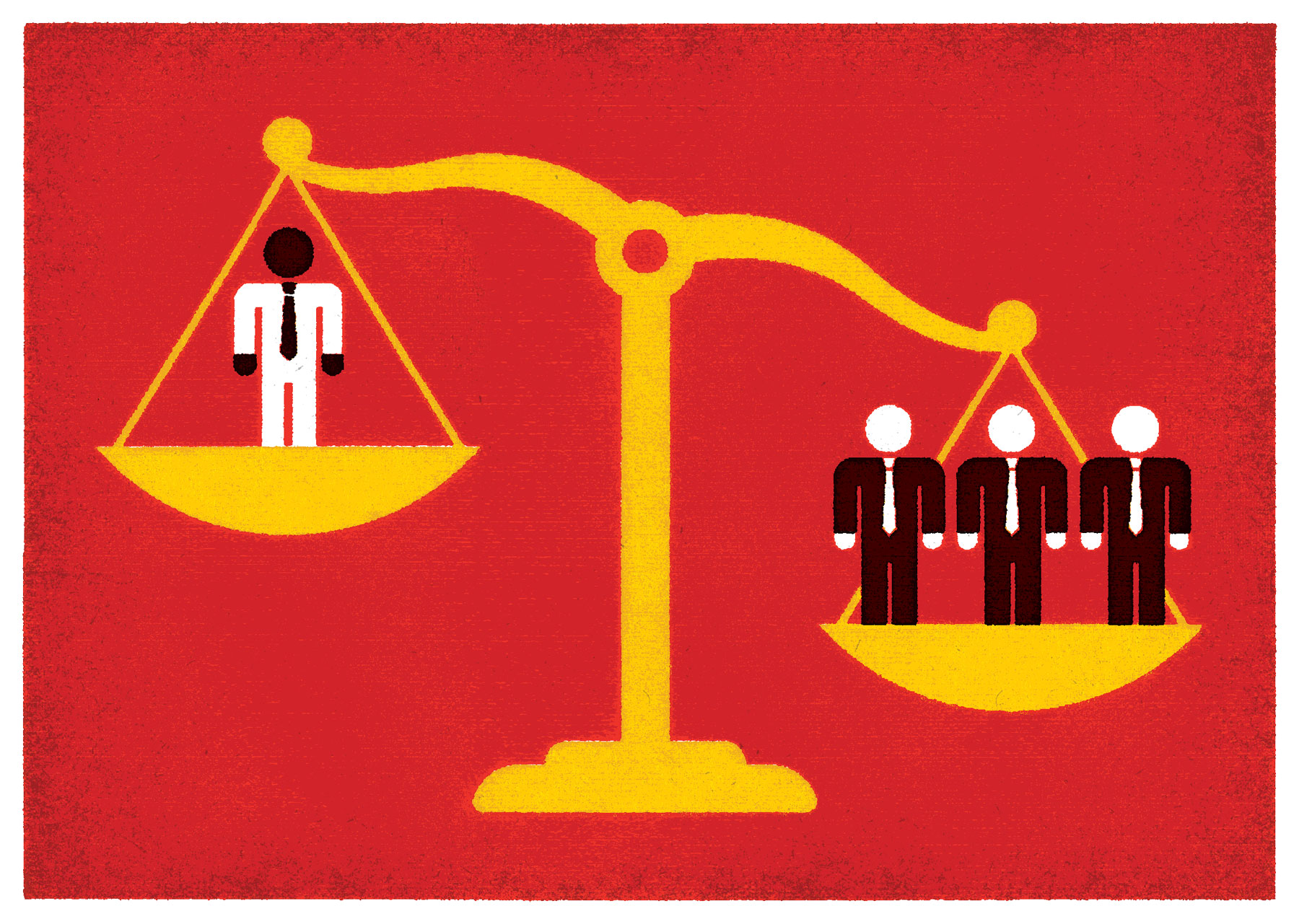Take a stroll through the offices of the biggest law firms in Dallas today and you’ll see the same sight you would have seen 20 years ago: an overwhelmingly white sea of faces. When it comes to diversity, Dallas’ largest firms continue to lag behind not just the Texas population as a whole, but also the ranks of attorneys throughout the state.
Despite minority groups combined now comprising 56 percent of Texas’ population and 15.4 percent of the total number of lawyers in Texas, members of racial or ethnic minorities make up only 12 percent of the number of attorneys at Dallas’ 16 largest firms. Minority representation is even more dismal at the top echelon, with only about 6 percent of the equity partners at these firms (41 out of 681) coming from African-American, Asian-American, Hispanic/Latino, or Native American populations. This represents a decline from the previous year, according to the 2014 annual Law Firm Diversity Report prepared by the Dallas Diversity Task Force, a collaborative effort between the Dallas Asian American Bar Association, the Dallas Hispanic Bar Association, the J.L. Turner Legal Association, the Dallas Women Lawyers Association, and the Dallas Gay and Lesbian Bar Association.
For the first time, the 2014 report charts firms’ efforts with regard to women and LGBT lawyers.
But pledges are easy to make and harder to keep. So beginning in 2006, the Dallas Diversity Task Force began compiling data from questionnaires distributed to the largest firms in Dallas and issuing annual progress reports. The reports calculate a firm’s composite score based on the number of minority lawyers at participating firms and their depth (the numbers of equity partners vs. other attorneys) and breadth (diversity across multiple minority groups). Firms are measured against both the benchmark of Texas’ population as a whole as well as the demographics of Texas-licensed attorneys.
The Task Force also goes beyond raw numbers and survey responses to a “firm efforts checklist,” which inquires into such subjects as recruiting efforts, whether firms have a diversity committee and a written diversity plan, and whether firms provide mentoring for minority lawyers.
With nine years of data upon which to draw, the Task Force’s report card paints a dismal picture. Over that time period, minority representation at Dallas’ biggest law firms is up only slightly, from 8.4 percent in 2006 to roughly 12 percent in 2014. Although Asian-Americans and Native Americans are represented as well as or better at Dallas’ largest law firms as they are among the ranks of Texas lawyers or the general population of the state, African-American and Hispanic/Latino attorneys fall short of both benchmarks. Even more disturbing: The 2014 report concludes that many of the admittedly modest gains in earlier surveys have been “eroded, in part, on account of the economic downtown.”
Minority lawyers were disproportionately represented among the ranks of those who had ceased employment with the reporting firms, comprising 18 percent of those who left. The composite scores for seven of the firms reported went down from 2013 to 2014, and four of the 20 largest firms—Baker McKenzie, Gray Reed & McGraw PC, Munsch Hardt Kopf & Harr PC, and Strasburger & Price LLP—elected not to participate at all.
Walking the Walk
But even this dismal picture had some bright spots. Jones Day’s Dallas office had the highest composite score of any responding firm. Hilda Galvan, partner-in-charge of that office, attributes the firm’s diversity success to a number of factors, chief among them being leadership. “Our firmwide managing partner is a true believer in giving people opportunities to succeed,” she says. “It has to come from the very top. If it’s not coming from there, partners at the mid-level can’t make it happen by themselves.” Galvan also points to the value of having actual examples of success to point to for prospective hires. “If having diverse lawyers in positions of leadership is one measure of a firm’s commitment to diversity, candidates see that at Jones Day,” Galvan says. “The partners in charge of our San Francisco and Atlanta offices are African-American, and both I and the partner-in-charge of our Miami office are Latinas. That helps attract students and laterals.”
Most important, Galvan notes, is creating an equal-opportunity work environment. “As a young female Hispanic attorney I was given the same opportunity to fail or succeed. That’s what kept me here,” she says. And although the firm’s participation in minority job fairs and other recruiting efforts is important, the changes in the legal market “will continue to affect everyone,” according to Galvan. That’s why it’s important, she says, for the clients hiring the big firms to insist that they actually “walk the walk” when it comes to diversity. “The message Fortune 500 companies should be taking is what they are already doing; are they hiring the diverse lawyers, and are they insisting that equity partners of color lead their team?” Galvan says.
If the task force gave out a “Most Improved” award, it would have to go to Locke Lord LLP, which increased its composite score by more than six points from last year. How has the firm made such strides? According to Managing Partner Don Glendenning, “We’ve made diversity a priority through reaching out to affinity groups in law schools, attending minority job fairs, and by reaching out to our diverse alumni who have gone on to wonderful careers at major corporations. The best way to attract diverse lawyers,” he says, “is to have them in the first place.”
These alumni help comprise the firm’s Dallas Diversity Council, along with roughly two dozen self-identified diverse attorneys within the firm. The resulting benefit, Glendenning says, is considerable: “These alumni not only lend their perspectives, but they also help serve as mentors to our diverse lawyers.”
As for the concern that Fortune 500 companies may be frustrated with what’s been characterized as the “glacial pace” of Dallas law firms’ diversity efforts, Glendenning is pragmatic. “Most large law firms are doing a better job than meets the eye,” he says. And besides, he points out, these very same companies often benefit from the law firm attrition of minorities. “Would we all like to do better? Absolutely,” Glendenning says. “But most Fortune 500s and other large companies understand and are grappling with the same challenge themselves. And the large law firms have traditionally served as a pipeline for diverse talent moving to the C-suite.”
The Task Force’s 2014 report itself reflects some change. For the first time, it charts each firm’s efforts with regard to women lawyers and LGBT lawyers, noting not only sheer numbers but also such factors as the percentage of participating firms providing paid maternity leave of at least 12 weeks (93 percent) and the percentage of firms providing healthcare benefits to same-sex partners or spouses (81 percent). These new inclusions, according to the report, “reflect the Task Force’s commitment to employing a holistic approach to diversity that emphasizes mutuality and inclusion. The Task Force hopes that this expansion will be a significant step toward creating a more comprehensive analysis of diversity within the large law firms in Dallas County.”
Filling the Pipeline Early
Progress aside, the flunking grade for diversity earned by Dallas’ largest law firms has been a constant issue over the years, even after the 2006 formation of the Dallas Diversity Task Force to publicly hold law firms’ feet to the fire. Statewide reports by publications like Texas Lawyer, which conducts annual women and minorities surveys, as well as national studies like The American Lawyer Diversity Scorecard and the National Association for Law Placement’s annual Directory of Legal Employers, echo Dallas’ abysmal statistics. But these studies also place them in context, illustrating that Dallas’ difficulties with hiring, retaining, and promoting minority lawyers are being experienced throughout the Lone Star State and nationwide, too.
What can be done beyond what law firms are already doing? John Treviño Jr., senior attorney for privacy at Hewlett-Packard and a member of the Dallas Diversity Task Force, has some ideas. “As a bar, it’s important that we continue to focus on pipeline efforts, to ensure that law firms have the pool of diverse attorneys to hire and promote to partnership,” he observes. “If we don’t increase the number of minority students entering and finishing law school, law firms are forced to compete for a very small pool of candidates. And it’s further complicated when you factor in corporate legal departments and government agencies all competing for the same diverse pool.”
One solution, according to Treviño, is to start filling the pipelines earlier at the elementary school level with outreach efforts by local bar associations. The Dallas Bar Association currently participates in a variety of pipeline programs to teach and guide local students of all ages, a few of which start at the elementary school level. (Programs from other local bar associations cater almost exclusively to high schoolers, law students, and postgraduates). The programs for the younger set include everything from art and essay contests to email mentoring and museum visits, and aim to pique children’s interest in the legal profession through hands-on learning.
“Realistically, we should be looking at this as a 10-year—or possibly longer—pipeline effort to get minority schoolchildren interested in law as a profession,” Treviño notes.
Until then, failing grades for diversity and the glacial pace of law firm shifts are likely to be regular fixtures.






